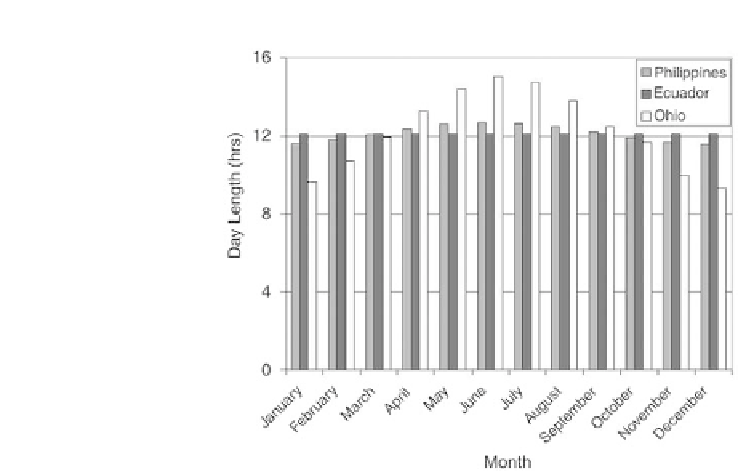Agriculture Reference
In-Depth Information
Figure
8.6.
Day-length differences between summer and winter at the three farms.
3
In both the Philippines and Ecuador the relatively constant temperature and rainfall
means that food can be grown all year around. On Leyte rice paddies are seen in all
stages of production at all times of the year. Some paddies will be plowed and ready
for planting while others will be newly planted, some with rice plants at midstage of
development and some heading (forming grain heads) and some being harvested.
Thus, the climate provides for constant food production.
However, high rainfall and high temperatures, as in Leyte, are not conductive to
growth of all plants, and so in some cases some crop plants are preferentially grown
in months with less rainfall such as April through June (Fig. 8.4). In other cases
crops may be protected from excess rainfall by putting a “roof” of transparent plastic
over the planted area.
In Quito, Ecuador, the relatively constant temperature also allows the production of
food all year around. As noted, the temperature is lower so crops that do not do well in
the Philippines will do well in Ecuador. Tomatoes do better in climates cooler than the
Philippines and thus do better in Ecuador.
As noted, crop production on the Ohio farm is limited to those months that are frost
free. However, some garden crops such as radishes and peas do better during the cooler
months while maize and watermelon do better during the warmer months. Also
any crop that takes a longer warmer growing season such as rice will typically not
be grown, although special conditions, not suitable for commercial or even household
use or production, can be arranged and thus allow the plants to grow and even produce.
This might mean starting and growing the plants in a greenhouse for a significant period
of time before planting in the field.








